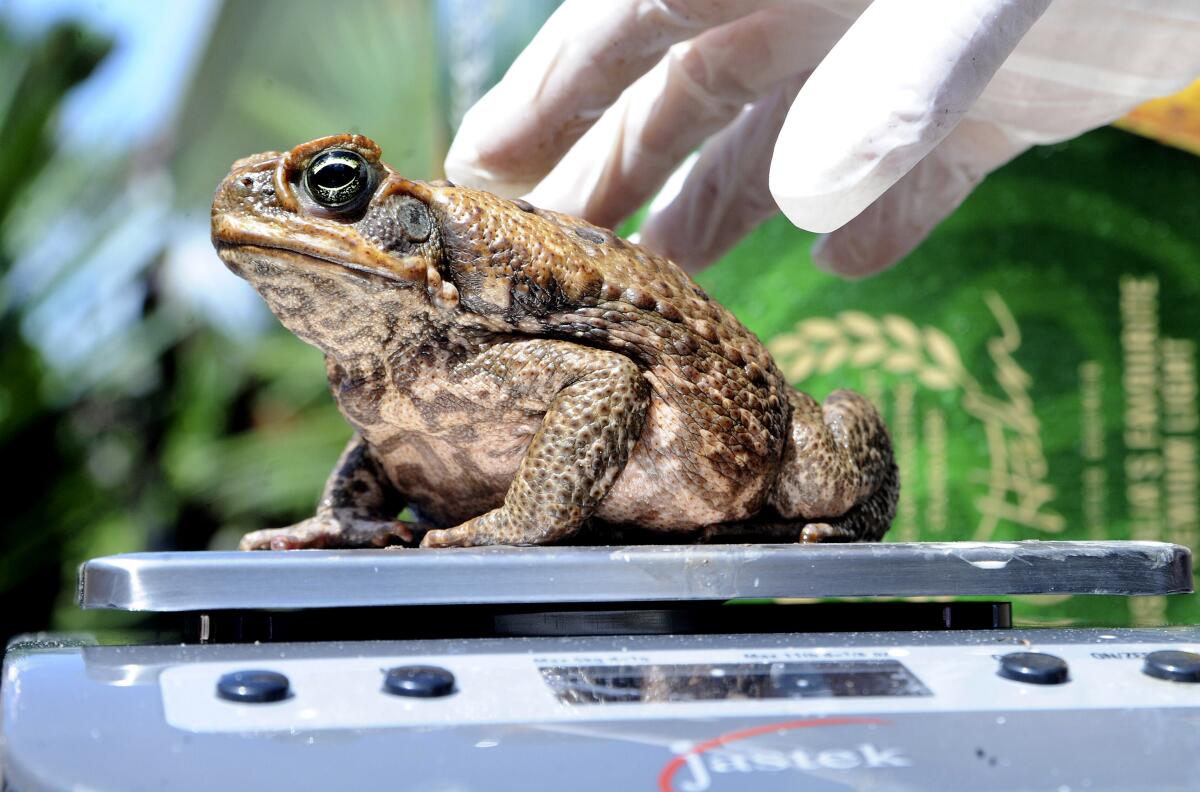Conservation scientists can train wild animals to avoid threats, but is it ethical?

- Share via
When large and warty cane toads were first brought to Australia nearly 100 years ago, they had a simple mission: to gobble up beetles and other pests in the sugarcane fields.
Today, though, the toads have become an infamous example of a global problem: biocontrol initiatives gone wrong. The squat creatures have spread across the top half of the country, wreaking havoc on ecosystems. Cane toads are highly toxic, and consuming just one is generally lethal for predators like monitor lizards, freshwater crocodiles and the small, spotted marsupials called quolls.
But what if you taught other animals not to eat the toads? Could you — and should you?
Conservation behavior scientists are doing just that with behavior-based management, in which an animal’s behavior is encouraged, modified or manipulated to achieve positive conservation outcomes.
In Australia, scientists are working with Indigenous rangers to teach predators not to eat cane toads. In New Zealand, researchers have used fake scents to condition ferrets, hedgehogs and other predators to ignore endangered birds’ eggs. Other behavior-based management efforts include re-teaching lost migratory routes to birds in North America, preparing captive animals for life in the wild in Colombia and using deterrents like colored flags to keep wildlife away from sites where they might conflict with humans.
This research has significant potential to conserve threatened species and reduce animal deaths. However, modifying behavior may come at a cost to animals or the communities they live in.
To address this question, we and our colleagues have developed a framework to help researchers evaluate the ethical considerations in modifying animal behavior against other options.
Behavioral interventions can conserve species and ecosystems without shooting, poisoning or trapping animals that people view as problems. This is particularly appealing where the animal is endangered.
Elephants, for example, are often killed by accident or on purpose when they wander into human environments like farmers’ fields or railroads. In Kenya, farmers and researchers have built “bee fences” that use elephants’ fear of bees to keep them out of crops. In some cases, it is impractical, publicly unacceptable or just undesirable to kill some animals in order to conserve others, or to achieve other wildlife management goals — like keeping seals away from salmon farms or coyotes out of suburbs. Behavioral interventions are increasingly viewed as a more ethical conservation and wildlife management possibility.
Yet such interventions also open up new ethical questions, or raise old questions in new ways. While avoiding poisoning or shooting animals can reduce overall harm, behavioral management may generate other forms of harm. For example, using aversive stimuli such as loud noises, harassment or mild pain to train species to avoid an area may cause distress and even trauma. In other cases, there are incidental harms to other species, such as animals killed to be used as “bait” in behavioral interventions.
Changing an animal’s behavior may affect local communities’ livelihoods and cultural practices, too, whether for good or ill — such as asking ranchers and farmers to use scent “biofences” to keep predators away from their livestock.
Some people believe deliberately modifying animal behaviors is unacceptable. For example, as California condors neared extinction in the wild, some conservationists pushed for intensive interventions and captive breeding. Others were so strongly opposed that they viewed extinction as preferable, arguing that the condor was better dead than bred.
Another potentially significant issue is “behavioral bycatch”: the costs for organisms unintentionally caught up in a behavior-based management project. For example, some fish farms have tried to prevent seals from eating their fish by using a device that plays an unpleasant sound — a seal’s version of fingernails on a chalkboard. But in one study, scientists discovered that toothed whales were even more sensitive to the sound and less likely to adjust to it. As a result, these non-target animals may be more prone to abandoning the area than the target animals.
To make wise decisions, wildlife managers need to identify the diverse values at stake in any given situation. This might involve cultural and heritage values — such as the significance of hunting in an Indigenous culture — as well as economic and aesthetic values. It will also likely include the welfare of individual animals, the health of ecosystems and perhaps animals’ ability to live with minimal interference. And managers have to be clear about what a proposed intervention is trying to achieve and how likely it is to meet that goal.
This approach would help wildlife managers and researchers focus on some of the key potential effects and compare those with other tactics. Today, virtually all conservation challenges have a human dimension, and it’s important to recognize that the most effective solutions may involve changing people’s behavior — such as controlling human food waste to discourage “problem bears.”
There is great promise in behavioral interventions for conservation, but also challenges. Slowing down to weigh all the values involved will help minimize potential harm and maximize benefits to both humans and wildlife.
Daniel T. Blumstein is a professor in the department of ecology and evolutionary biology at UCLA. Catherine Price is a behavioral ecologist at the University of Sydney. Thom van Dooren is an associate professor and deputy director of the Sydney Environment Institute at the University of Sydney. This article was produced in partnership with The Conversation.
More to Read
A cure for the common opinion
Get thought-provoking perspectives with our weekly newsletter.
You may occasionally receive promotional content from the Los Angeles Times.









